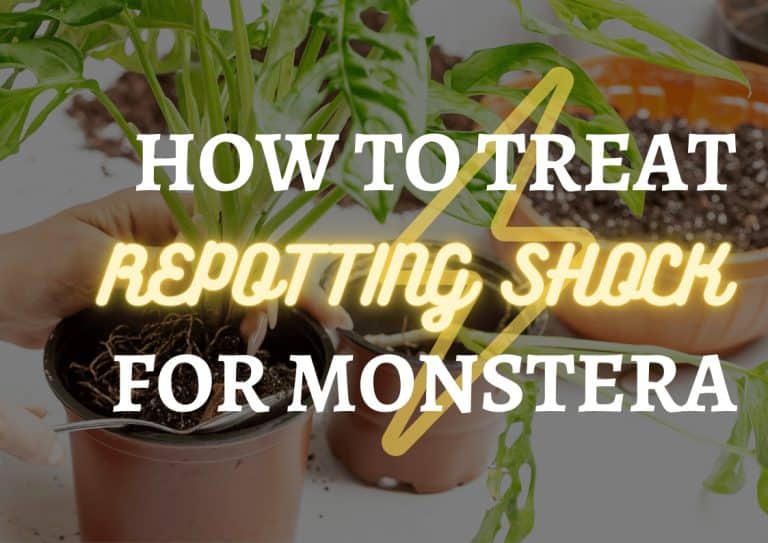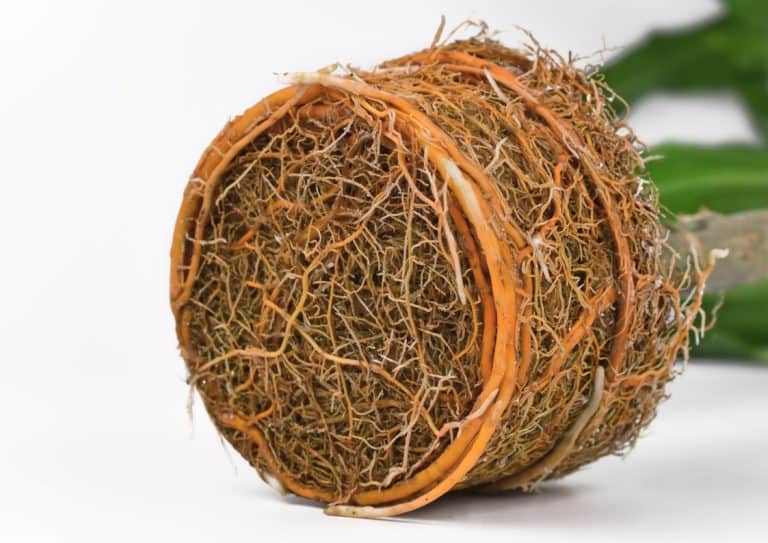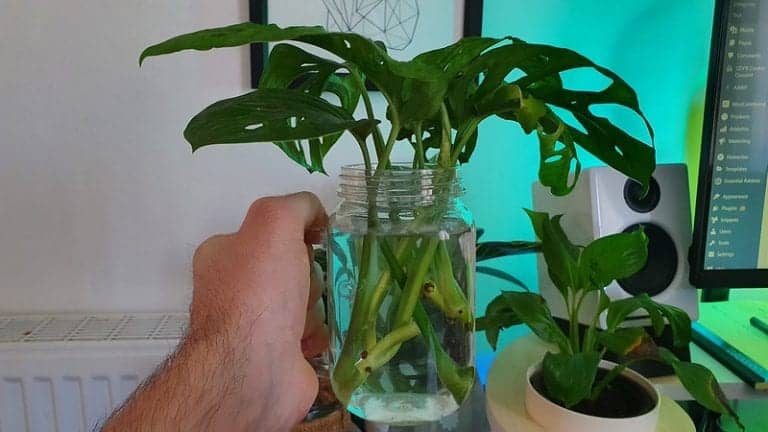Monstera Repotting Shock (Plant First Aid)
- Lakeisha Ethans
- November 27, 2022
If you buy something using the retail links in our articles, sometimes we earn a small affiliate commission. This does not impact the products we recommend.
Repotting is a normal part of owning a houseplant and it’ll be a necessary step to take at one point or another for all indoor plants as they grow.
With that being said, plants aren’t exactly “designed” to be repotted, or moved at all for that matter! In the wild, being transplanted to a new location just isn’t a thing.
This is why fast growing plants such as Monstera that do eventually need to be potted up can struggle to adapt and may even show signs of wilting after being transplanted. This suffering is commonly referred to as ‘transplant shock‘.
Shock experienced by Monstera after repotting isn’t something that can immediately be cured, however you can apply basic plant first aid to prevent long-term damage or death of the plant. Steps to treat repotting shock involve carefully meeting desired growing conditions such as ample indirect light and infrequent watering of an aerated substrate.
For the most part, Monstera repotting shock is temporary, and if otherwise healthy the plant should eventually adjust to its new surroundings.

How can I prevent Monstera repotting shock?
The most important step you can take to prevent repotting shock is to ensure the preservation and protection of your Monstera plant’s roots. Roots are how your plant is going to get its nutrients and survive, and it needs to have them intact to adapt to its new home.
As such, you should try not to disturb your plant’s roots when you repot it. Be gentle and break up root masses with a light and cautious touch. You should also never loosen roots unnecessarily.
This also means you should try bringing as many of your Monstera’s roots along to the new pot. Unfortunately, this fact is related to another very common and easily overlooked cause of repotting shock: incorrect transplant time.
As aroids, Monsteras find ways to take root just about anywhere. This fast rooting can trick less experienced owners of this plant into thinking that it is sufficiently mature for repotting, but this is not the case. This is because Monsteras can root in crumbling spots and often don’t do so tightly or reliably enough right away.
This is why you should only repot a Monstera when it has become root-bound, meaning that its roots have become highly tangled and formed a tight ball that no longer allows for any new growth. This seems like a bad idea, but it is essential so that the Monstera has completely adhered to the soil it is planted in when you move it. As such, its roots will be easy to move in a single clump and can all be saved.
It’s a good idea to pot younger plants once a year to help growth develop, but more mature Monsteras will likely only reach that root-bound phase every two or three years. And, of course, repotting should be done in the event of infection or fungal growth or due to other extenuating circumstances.
Do note that you should never try to repot a Monstera during its dormant phases, which are periods when you should be taking precautions to protect the plant. Spring and Summer are the ideal seasons to move these plants, as your plant will be able to recover more quickly with the natural growth spurts of these growth periods.

How should I protect my Monstera if its roots have to be pruned during repotting?
There are times when you’ll have to remove roots that are damaged, rotted, or infected. In these scenarios, you’ll be unable to preserve your Monstera’s roots entirely as you repot it.
Unfortunately, this almost always leads to unpreventable repotting shock.
To mitigate this, pinch, prune, or trim the topmost growth of your Monstera plant foliage during the transplantation process. This allows the plant to use its energy and growth hormone, auxin, on root regrowth and re-establishment instead of on all the leaves it has to support.
Incidentally, this is also a great time to collect Monstera plant cuttings. When you pinch off these top growths, if they’re healthy, you can propagate them if that’s something you’re interested in. It’s a great way to make the most of an otherwise unhappy situation for your plant.
Using a promoter for root growth on your Monstera is also acceptable if its roots have to be removed in large portions. Don’t use normal-strength fertilizer, as this can actually cause burns on damaged roots. If you do have to use some type of fertilizer, halve its strength and dilute it before doing so.

How should I properly care for a Monstera with repotting shock?
Transplant shock refers to the negative influences brought about when a plant experiences an interruption in the flow of nutrients and water being taken up by its roots system and in Monstera this can result in yellowing leaves.
So the most crucial part of dealing with repotting shock is ensuring that that equilibrium is restored by meeting the Monstera’s desired growing needs as accurately as possible. You should start this care immediately after repotting any plant, even if it doesn’t show signs of shock.
Water your Monstera well straight after repotting to make sure roots are in contact with substrate and can draw upon moisture when required.
Don’t blindly continue the same watering schedule you used before the repotting process, as this could compound any problems. Instead, use your best judgment to adjust the watering frequency accordingly to the new pot, new potting mix and potentially new location.
Lighting is another crucial factor in managing a Monstera’s repotting shock.
Do not provide excessive direct sunlight to a Monstera that is suffering from transplant shock, as this will scorch the already suffering foliage. Instead, focus on indirect light sources and use your best judgment to determine whether your plant needs more or less light.
The bottom line here is that the best cure is proper care and patience. Allow the plant to regain some sort of balance and refrain from interfering too much.
Take home message
The best cure for repotting shock in a Monstera is patience and normal care, adjusted to fit the Monstera’s responses to this care. Correct water and light provision are paramount in this treatment.
You can also prevent repotting shock to some degree by ensuring that your Monstera is fully root-bound before transplanting it to a new pot. Again, preserving its roots and protecting them from damage is central to ensuring your Monstera is able to recover quickly from the repotting process.
If you need to remove roots when repotting a Monstera, make sure to trim off some of its leaves to compensate. You can also use a special hormone to promote root growth and speed up recovery.
Our Favorite Houseplant Soil Mixes And Substrate
Similar Posts
Why Are My Monstera Aerial Roots Shriveling?
Should you be worried if the aerial roots on your Monstera starts shriveling up? Does this happen naturally or is it a sign of a poorly plant?
Monstera Siltepecana vs Monstera Peru: How Do They Differ?
Monstera siltepecana and Monstera peru are sometimes confused despite being very different plants. Here's how to ID each & meet their unique needs.



